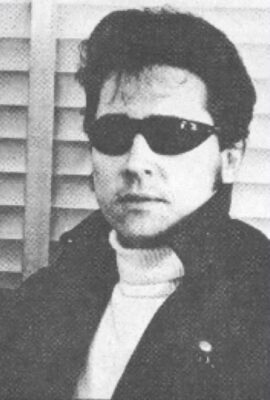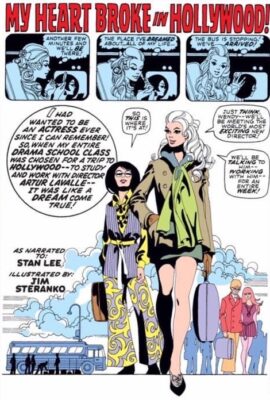John A. Mozzer Interviewed 5 of Steranko’s Associates in 1973
1973 Intro by John A. Mozzer, Interviewer
My name is John Mozzer.
Jim Steranko, comic artist and escape artist of Reading, Pennsylvania is so involved with his current projects that he has neither the time nor the interest in searching his mind to recall his life of the past, or to reflect upon his previous achievements, especially in front of a tape recorder.
Also, he has been interviewed time and time again. As a result, the following is a series of interviews conducted with various people who have had contact with Jim Steranko at one time or another in their lines. Each one of the persons present reflections upon their acquaintance with the man.
First, we have Leroy Mingus, owner of the Mingus Magic Shop in West Reading, who recalls Steranko’s visits to the shop as a boy. He is followed by an interview with Ken Fisher, editorial cartoonist of the Reading Times newspaper. Then you will be introduced to Quentin Minker, who established the Milford Associates Advertising Agency in Shillington, Pennsylvania, where Steranko served as art director.
You will see that it is interesting to get various viewpoints from people other than Steranko himself about Steranko’s life. Each one of them exhausts their knowledge of this person.
[After this introduction was recorded, Robert Post of Rieck’s Printing and Eve Machemer of The Book Store were also interviewed.]
On Steranko 1940s – early 1950s: Leroy Mingus Of Mingus Magic Shop, 1973:
Mozzer:
Your name is Mr. Mingus, that’s really all that I need to know. Mr. Mingus.
Mr. Mingus:
Yeah.
Mozzer:
And you set up the Magic Shop when?

Mr. Mingus:
Yeah. I’ve been in the entertaining business for about 50 years. But I also been manufacturing magic for about 25 years now, or over. We manufacture all professional magic, particularly flower magic, which is of course shipped internationally. My business at one time was at the 408 Penn Avenue, West Reading. And I’ll never forget one cold day, when a very little boy and his father came over to see me, and his name was Steranko, James. So of course, like all children, he wanted most everything that was in the shop. And the father and I tried to convince him that would be, to buy something that would really be good for him, and of course they did. And thereafter, that little boy and his father used to come to see me at different intervals.
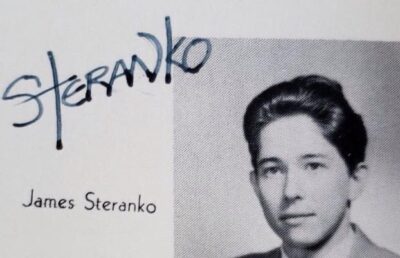
Mr. Mingus:
Finally, James grew up, got a little older and he used to come by himself. So during the moving picture of The Life of Houdini, seemed to fascinate most all young boys at that particular time, particularly Steranko. And he decided that he would like to be an escape artist. And I’ll never forget, he used to come over and show me the little picks that he would make for locks, very, very ingenious. And a good friend of mine, who has passed away by now, Russell Snell, took an interest in James also. And made arrangements for him with the city police, to be locked into city locker. And of course, Steranko got out of it very, very conveniently, it was quite the Friday publicity stunt.
Mozzer:
How old was he?
Mr. Mingus:
I would say he then was probably 14, maybe around 14, 15 years old. Later on in years he became more interested and I took him, also when he went along with me to Boston, at the Society of American Magicians convention. And he had a great time. He also accompanied me at another convention, I just can’t recollect exactly where it was, but I do think it was Baltimore. Then, I hadn’t seen him for quite a while, and first thing I know why, he started to publish a book on cards. And he also published a book on escapes. It was published by Frances Ireland [Magic, inc] in Chicago. At that time we communicated quite frequently because he wanted to tell me about his book, and of course all the progress that was being made.
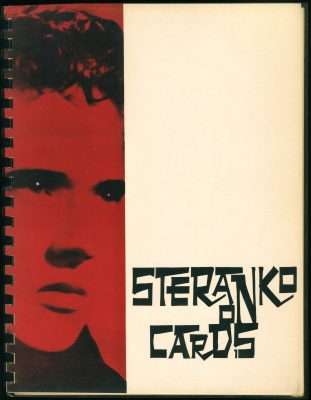
Mr. Mingus:
I haven’t seen Frank for several years. I haven’t seen Jim for several years, but I understand he’s in the publishing business, and now is spending most of his time at commercial art, right? I always called him James.
Mozzer:
Some people call him Jim.
Mr. Mingus:
Therefore, until I see him again, talk to him, that’s about all the information I have on him.
Mozzer:
Okay, thank you. What are the conventions like? What takes place at them and what did the Steranko do there?
Mr. Mingus:
What did he do?
Mozzer:
Yes.

Mr. Mingus:
Well, you don’t do anything really except participate in all the events. They have originality contests, and they have which person can show his original trick, and it’s subject to a trophy if it’s the best. And there’s continuous closeup shows at these conventions. Lectures and nightly shows, that is stage shows, everything pertaining to magic, of course, and then also a banquet. And that’s about all. The dealers are there with their merchandise to sell magicians their needs. And it’s just a nonprofit organization, but it accumulates all of the people that are really interested in magic, or as we say, has the bug.
Mozzer:
What does IBM stand for?
Mr. Mingus:
IBM stands for the International Brotherhood of Magicians.
Mozzer:
And you say you don’t know whether this Steranko was a member or not?
Mr. Mingus:
I do believe that he was a member at one time, of our organization here, which is called the Mingus Magic Ring Number 57. Now, each town has a ring, they call it a ring instead of a club because the international name is, that is the magazine that is published by the International Brotherhood of Magicians, is called The Linking Ring. Now all over through the country, wherever there’s accumulation of magicians, they form a little club, which they call a ring. And you’ve got to belong to the international first, and then you belong to this local ring, and you also receive their trade magazine.
Mozzer:
Okay. Anything else?
Mr. Mingus:
I think that’s all.
On Steranko 1953-1971: Ken Fischer Of Reading Times, 1973 (interview conducted with Ron Schira):
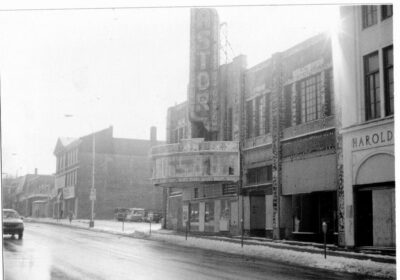
Mozzer:
First tell me a bit about yourself. How did you come to work for the Reading Times?
Ken Fischer:
When I was in the Marine core, I had about six months to go before I was discharged and I was working on a comic strip called ‘Walley the Bum’ and I came home on leave brought that strip in to show to Gensler, who was the Times cartoonist at that time for the Reading Times, and he gave me a couple of instructions how to correct this thing, how to improve the strip. So I buzzed back to the marine core, and before I could get my discharge I had to go through a hernia operation which meant I couldn’t work when I got out, which was agreeable to me, but still, you were out of employment.
Ken Fischer:
And I used that time then to work on this comic strip, and at that particular time they moved Gensler from the Times up to the Eagle, and he had remembered my strip and then got a hold of me. And by dumb luck for once in my life I had worked, actually completed an art project which pleased him and then he asked me if I wanted to come in here, which I did. In a way it was a good break, but it put you in a rut. [Directed at Ron Schira, because he is attending Philadelphia College of Art:] It would be much better to go to school like you’re going, than to come in to a one slot job. You’re going to get an overall background, where I was just doing the same type of thing year after year.
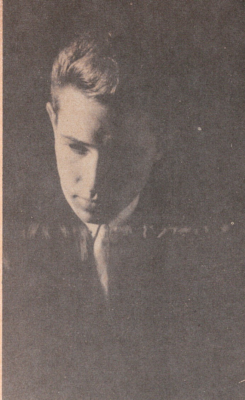
Ken Fischer:
And after about 10 years of this type of thing, you realize how slotted you are. And the outfit, no matter where you go, knows you don’t have art school or college after they’ve got you. And they aren’t giving you the money they should because the figure you don’t have the educational background to move on. So at that point, then I went up to Kutztown and picked up my degree and things changed for the better since then, just picking up the degree.
Ken Fischer:
The other drawback about working for a newspaper that I find, as far as comic work goes, you don’t have any particular character. You have to draw everything as far as general figures, and after a while you get a nondescript man and woman representing humanity. It’s strange. And all your men start to look alike, except for maybe one is black hair and one has blonde hair. And your women are the same way, and your children are generalized. In other words, you’re not really going for one specific character and why you’re humoring everything is specific, your real individual characteristics are not coming out like it should.
Ken Fischer:
To me, this is where someone like Jim Steranko has a big advantage over anyone working here at a newspaper, because Jim can really take a character and go into all his qualities. Good, bad, and indifferent. He has a much wider range than we do in here. We have too many editors sitting on our backs that say no, and this and that. And we have to watch color, we have to watch religion, all kinds of crap. While Jim has to watch it, he doesn’t have to be as careful as we do. So it’s much more advantageous to work on a comic script like Jim does, or anything in that line rather than this general stuff here.
Ken Fischer:
And editorially, it’s all this crap about the newspaper freedom of press and so forth. That’s all a bunch of jazz because when you get down to it, the company is still owned by either a group or an individual. And if they’re Republican, they have Republican viewpoints, and if they’re Democrat, they have Democratic viewpoints. So it’s just another business and you’re really limited in the ideas that you can project. You’re virtually told what to do constantly, which gets annoying. So Jim’s been pretty lucky that he’s over on the other side of the fence, I think so.
Mozzer:
Okay. Well, how did you meet Jim?
Ken Fischer:
Jim, of course I was in here about five years and Jim came in like many young artists do. We might get five or six kids a year and Jim just popped into the art room and fortunately, both of us were there. I’m literally the night man. I work for the morning newspaper and the other chap who works for the afternoon paper normally would leave about four or five o’clock. And Jim popped in late afternoon, caught both of us and just showed us this fantastic artwork, which knocked us both off our heels. Here’s this kid about 15 years old asking us what we might suggest to improve his work, and his work was already so far ahead of ours that it was just pathetic actually. And it’s a thrill to see someone with that much talent come in.
Ken Fischer:
And I think as I recall, Gensler, the older artist, suggested a little more shadow work and stuff like that. The work that Jim showed us was the oil paintings of faces and figures and things like that. Very dramatic, very strong, he was getting a real strong feel of action, even at that point. And you were just astounded by the quality of the work. You know this fella hasn’t been published, you know he is going to be published, and you have a strong idea that he’s going to be a big name, which of course he is today.
Mozzer:
How about the editor’s opinion?
Ken Fischer:
Yeah, that’s a good point. When Jim came in, at that time long hair wasn’t in, and Jim of course was really already spaced at that time. Beautiful long hair. He was dressed completely in black, had a black leather jacket, real tight black trousers and black boots. Good old mysterious black Jim came in, and I think it was the second time he bopped back in, Gensler wasn’t in at that time it was just myself. I was talking to Jim and this editor walked by, who at that time was our city editor and is now our managing editor unfortunately, so this tape won’t be heard obviously. But at any rate, this joker sticks his head in and he just looks at Jim in shock, and this is Mr. Straight himself. Today he still has a crew cut and the whole routine. So sometime later that evening, he calls me back in his office hey says, “Who was that joker in your room?” I told him, “Young fella has some really great artwork and we’re working together on it.” He says, “Don’t let them in the building anymore.” He says, “I don’t want the guy dressed like a bum in our building.”
Ken Fischer:
So when Jim came in the next time, I said, “Hey, we either have to close the door or hide you. We have an uptight guy in here that doesn’t appreciate the way you dress.” And Jim really at that time was too far out to go into any art place around here. You could do it in New York with no sweat, or Philadelphia. But around here you couldn’t walk into Beaumont, Heller & Sperling [referring to an advertising agency located on Walnut Street in Reading] or anything like that. So I said, “Look, Jim. Dressing in black’s fine, but take off the leather jacket and just break it down a little bit. You don’t shake these guys, like the editor, that this disapproves of this. You can go in with your portfolio and let your work speak for yourself. You don’t have to be that dramatic actually,” because Jim is literally still on stage wherever he went, and this is the way he is still today.
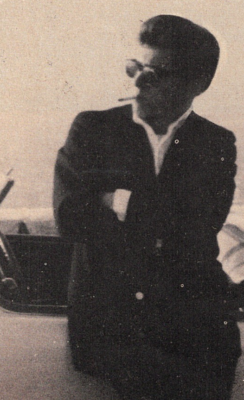
Ken Fischer:
So the next time he popped in, he had a black sport coat on, a black turtleneck and black pants, but he looked sharp. And I think the thing that offended this joker at that time was the black motorcycle jacket because this somehow threatened him. So I used to sneak Jim in and he’d come up and we’d just go to the back portion of the room if we hear this guy lumbering around. He’s pretty loud in his voice, you could tell he was around, so we just kept quiet until the guy got out of sight. That’s the way we handled it.
Mozzer:
Did Jim cut his hair?
Ken Fischer:
No. No, he didn’t. This was part of the stage presentation at that time. I think he was in this rock group at that point. There was no reason for him to, really over adjust, for someone who wasn’t going to employ him or just casually make a comment like that. When he went up to work at his first job which was at Rieck’s printing on Pair Street at the time, they’re now over in West Reading, and Jim was hired at $2.50 an hour as their artist. He worked there two years, then of course Jim modified his dress somewhat there, which is one of those things.
Mozzer:
You know Mr. Post?
Ken Fischer:
Yeah.
Mozzer:
He owns Rieck’s Printing.
Ken Fischer:
Yeah. Right. And of course Jim is still a very good friend of Post, still does occasionally emergency jobs or something like that from what I hear, if the Post really gets in a jam.
Schira:
What kind of artwork did Jim do for them at that time?
Ken Fischer:
Mostly just straight layout for flyers, anything that had to be printed. He’d do type layouts, occasional illustrations, anything in just the general printing line. It was just a small print shop at that point. And the interesting part to me was that Jim already had enough savvy at that point to smell the buck. He knew he was only obviously getting $2.50 an hour, and somehow he found out that Post or whoever had charge of this outfit was charging five bucks an hour for the artwork. So of course then Jim made the approach for more money. He wanted more of the share of the profit there, and was turned down as I recall, I’m not quite sure about that. There was some kind of hassle there. Then the next thing I knew he was over using the space with Minker. He had some kind of arrangement that he had space at Minkers. He would do X amount of jobs for Minker. Whether they were jobbed over to him or not, I don’t know.
Mozzer:
Did he go directly from Rieck’s Printing to Minker?
Ken Fischer:
Yeah. As I recall. Now, this is quite awhile back.
Mozzer:
I understood he was a sign painter, graphic designer.
Ken Fischer:
Well, he covered quite a bit of those at Rieck’s, that type of thing. Now he you might’ve been continuing this, my recollection is that he went right over to Minker, which was a much better deal and really got into some nice heavy stuff at that point. And then instead of just screwing off during his lulls in the business, he really went into some good cartoon type illustration comic work, and that’s where he got started in the illustration of the comics.
Mozzer:
What was your reaction when he got into the comics?
Ken Fischer:
Well, his work was just so superior that my reaction was that I was really curious whether he could crack the market or not. I really was, because you hear all these stories of guys that go up to New York with great artwork and stuff and come back disappointed and so forth. And then after about two years at Minker’s he worked up a series of fantastic drawings about 18 inches high, I don’t know if you’ve seen them or not. He had Huns, these warriors of the past with the fur and big swords. Attila the Hun and all that stuff. They weren’t copies, they were his own characters and he had these nice, big, beautiful, fresh looking drawings and brush. And he finished, he colored them in and he told me, he said, “I’m going to take these up to New York and see what happens.” Those are the drawings that got him in to the comic business. They were really, really fantastic. He had some good, sexy looking babes there, as only Jim can draw.
Mozzer:
I heard this story different, that he took in a penciled, 20 page comic strip of Super Agent X.
Ken Fischer:
Maybe he did.
Mozzer:
Maybe he took both.
Ken Fischer:
Maybe he took both, it might’ve been a combination. As far as I know, those were the drawings that he told me he was going to take to New York and just make the rounds to see if there was any possibility, what his talent was and so forth. I didn’t see any pencil thing of a secret agent. Well according to that then, he would have had to come up with the character secret agent X.
Mozzer:
He created it.
Ken Fischer:
That was his creation then. Maybe that’s it. But if he created it, that would still be his comic strip, wouldn’t it?
Mozzer:
He was willing to let it be the property of the comic book company with the agreement that he would do it for them, but that never came about. So it’s still his property.

Ken Fischer:
It still is his property then.
Mozzer:
There was almost a Paramount animated cartoon on it.
Ken Fischer:
Yeah. That’s interesting. So it’s a wonder he doesn’t publish now, with his own publishing.
Mozzer:
I think he will in a portfolio first. You mentioned the rock group he was in. Tell me what you know about that.
Ken Fischer:
Well, he played down at the Spartaco’s, and to me it sounded good. My wife and I were down there, a whole gang of us, and of course Jim’s up there cavorting on the stage. He’s really getting into it, really bending down with the guitar and stuff and stomping his feet. Then he’d go into a little foot shuffle, how you would get into, and we were having a ball. But I years later I ran into a guy that was pretty strong in the music world, at least in this section, and he knew Jim of course and I ask him his opinion of Jim’s musical ability. And he said, “As good as he is in art, he is that bad in rock.” Or it was that bad at that time. This could be true, I wouldn’t be a good judge of it. His music sounded good to my ear, but I don’t have a trained ear of course to judge. He didn’t stay in it too long.
Mozzer:
I understood 10 years.
Ken Fischer:
I don’t think he was in that long.
Mozzer:
That’s what I read. I’ll have to look into it.
Ken Fischer:
Check on that if you get a chance
Mozzer:
Well what was the name of the group that he was with, that you saw?
Ken Fischer:
His brother was still playing– The Spadesman, I think it was. I’m not sure.
Mozzer:
Steve?
Ken Fischer:
Yeah. Is Steve still playing with them?
Mozzer:
I have no idea.
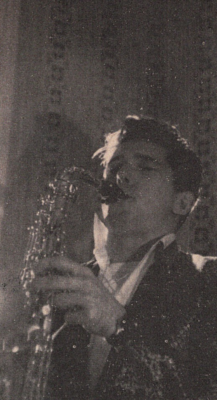
Ken Fischer:
He was for a while. From what I can remember, I think Steve had a little more musical talent than Jim did. But Steve has not been in the other line and Steve today is repairing electric shavers for Norelco. Goes around to the different stores and you take your shaver in and they’ll clean it up for you, which he has his own franchise there so he’s doing okay. But I was talking to Steve about Jim, and this was down at Boscos-
Mozzer:
When was this?
Ken Fischer:
This was about 8 months ago. And I was telling him of course I knew Jim and so forth. And you get the feeling that there’s a pretty strong bond between the two, but there hasn’t been that much communication in the last couple of years. Steve didn’t seem to know too much about what Jim is doing.
Mozzer:
I think I know more about what Jim is doing than he does.
Ken Fischer:
Yeah. I would go on with this. And I remember mentioning a few things, whatever they were, to Steve. And it was news to Steve, that Jim had done these things. Now of course, this could be just two brothers taking off in two different directions. One doesn’t care about the other until later in life and then you come back and search one another out.
Mozzer:
You say that a month ago you talked to him?
Ken Fischer:
No, that was about eight months ago.
Mozzer:
Eight months ago?
Ken Fischer:
Yeah. A good eight months ago.
Ken Fischer:
I remember one incident we were up at Lake George, which is up in New York state, on vacation, my wife and my daughter and myself. And a couple of miles below Lake George there’s a little frontier town with kiddy rides and so forth. And we took our daughter down to this place and they had a little, vaudeville show with a couple acts, one of which was a magicians act. And two young magicians where doing things, they were cutting up a carrot then the carrot would become whole and different little tricks like that. Nothing super fantastic. But just on a lark after the show, since their act was last and they were just cleaning up the stage there, I walked over and I had no idea how famous Jim was, at least in the magic world at that time. And of course he hadn’t broken into the comic world.
Ken Fischer:
I walked up and I started to chat with these guys and telling them that this friend of mine is also a magician. And of course they’re kidding me about this thing, “Yeah, what’s your friend’s name?” And so forth. And I mentioned the name Jim Steranko and both their mouths open up in stunned disbelief. And the one chap sent his buddy back to their dressing room to get magic magazines, go back and get whatever. This guy comes running back with this magic mag and Jim’s picture is on the front cover. And I was just as flabbergasted at that point. And these two guys are all excited because they want to know how well I know him, where he lives, what kind of pad lives in and what he eats, what he wears and all this stuff.
Ken Fischer:
And I tried to give them as crazy an answer as I could and reply to all this stuff, to do it the way Jim would do it, or the way I thought he would want it done. I described his pad as something really fantastic. At that time aluminum wasn’t in or anything, I said he had aluminum sheets for wallpaper and a big gong instead of a doorbell. I was going through all kinds of crap. And his eating habits, of course at midnight was the only time he ever ate and things like this. He only drank certain juices and I said he had a black magic room that he’d let no one in and all kinds of crap, whatever I could think of.
Ken Fischer:
And I remember coming back to Reading then, and of course giving Jim a call about this, and some of the commercialism of Jim at that point came out. He was more interested in what I told him than who the guys were, which was a little revelation there. But Jim didn’t give a shit about the guys themselves, who really were interested in Jim. His only interest was that the legend, no matter how much it had been exploited, was continued, which was to me an interesting insight. That Jim was strictly interested in this stage projection type thing and he could care less about the two guys who were interested, they were just two more fans at that point.
Mozzer:
Tell me about his rabbit.
Ken Fischer:
One night I went up to his apartment, which at that time it was down in South fifth street, third floor. And he had this apartment laid out as exotic as he possibly could, and I didn’t know he had this damn rabbit in this apartment. I’m standing there talking to him in the living room and I feel this nibbling at my pants cuff. And Jim of course knew the rabbit was there. I didn’t know what the hell was down there and I didn’t know what the hell he had in his apartment, because this whole thing is real weird at that time. And I didn’t want to show I was over concerned about it and I was trying to play this thing real cool, but he saw me trying to glance down and of course he said “That’s just Harry, my Belgian Hare,” or whatever the name of it was.
Ken Fischer:
I looked down at his rabbit with these huge ears down there, real friendly little thing. He was putting around there for a little while and he said that he had a little cage, as I recall, in the bathroom because this rabbit would get it out. And he said he has no respect for culture. And Jim as you know has this collection of valuable books and all kinds of drawings and stuff and this little rabbit would… If a corner of the drawing was sticking out he’d chew it. Then he went on to tell me about some of the books that this rabbit has destroyed and stuff like that. But it’s interesting because I don’t think Jim would tolerate that from a woman. If a girl or someone he was dating would destroy something I’m convinced he would get rid of her. That would be the end. But this rabbit was getting away with murder. So it was a humane quality of Jim that snuck out there. I don’t want to infer that he’s not human, because he certainly is.
Schira:
It’s this feeling that the rabbit is not responsible for it.
Ken Fischer:
Yeah.
Schira:
But a human being would know what it was doing, if it destroyed something it would be purposeful. The rabbit doesn’t even think about it.

Ken Fischer:
Right. It’s strange. He just seems a little more impatient with people than with animals, or at least with that particular animal, which may or may not be interesting. I can remember one time he me a call and he says “Are you going up to New York?” And it just happened I was that particular weekend. And he said, “Can I go along?” I said, “Sure.” His car was in the shop or something like that. At that time he had a big Cadillac. So he’s going up to New York with us and he’s telling me about he’s supposed to design the sets for this French movie director [referring to French film director, Alain Resnais.]. There’s supposed to be a movie on de Sade. They had made a movie on Marquis de Sade before, I think it was an English movie, and the French were up in arms because this wasn’t a true depiction of de Sade. And de Sade of course was a Frenchman and now they wanted to bring out a more true to life version of this particular man.
Ken Fischer:
And Jim had received this call from France and this fellow had asked him if he’d be interested in designing sets and he said he was going up to New York to see this guy. And this was a little too much for me, the guy from Reading. I thought, “Is he putting me on?” So what if he is, that’s his business. So we get up around 37th street or 38, somewhere in there and we buzz over to 6th Avenue or 5th, or someplace and he said, “This is the spot, drop me off.” Which I did, and we had agreed that in one or two days, when we were ready to leave that Sunday I was to call a number he had given me and check with him whether he’s ready to go back.
Ken Fischer:
So of course we go through our weekend and so forth and I call this number and this real French sounding female answers. She says monsieur this and monsieur that. I asked for Jim and she says, “Certainly,” she says, “Just one moment.” And it was no fake and I was standing there completely stunned because I knew then that he was really into this whole thing. So we picked him up, down at some corner close to where we had dropped him off and he’s telling us about all this fantastic weekend he had with this director. How they’re going through all the possibilities of different things they could do, different effects and so forth. This guy had to go back to France and also over to England to set up financing and so forth and Jim would know in six months whether they had the job or not. Of course, then would have to go over to Europe to set up this whole arrangement. But the thing, unfortunately, never came off. But it’s interesting that Jim was selected to do this and it’s quite an honor just to be selected, I think
Mozzer:
When was this?
Ken Fischer:
I’d say about two years ago.
Mozzer:
I recall him telling me about that.
Ken Fischer:
Do you remember that?
Mozzer:
Yeah. He said he was waiting for a telegram to go to Europe.
Ken Fischer:
Yeah. Right. That would have been it.
Mozzer:
But it never came.
Ken Fischer:
Never. Yeah. Right. Because I checked with him later and I forget whether the guy couldn’t get money. There was some kind of a hassle and the whole thing was abandoned. But it was really exciting just to know someone that was already operating on actually an international scale at that point.
On Steranko 1959-1963: Robert Post Of Rieck’s Printing, 1973:
Steranko worked for Rieck’s Printing from from January 1959 to May 1, 1963.
Mozzer:
Your name is Robert Post and you’re president of Rieck’s Printing?
Robert Post:
Right. I’ve been asked to give you my impression or my thoughts about James Steranko. I’ve known Jim for more years than I want to remember. It goes back to when Jim was in high school, I met him when he was doing escape work. Jim didn’t know me at the time, but I was very interested in Jim.
Mozzer:
Did you go to the same high school as Jim?
Robert Post:
I went to the same high school, but we were not in the same age bracket, so I was out of school when Jim was in school, but it was played up in all the papers when Jim was in high school, when he started with the escape bit. Jim impressed me as being one of the most talented people I have come across in my lifetime. I was very fortunate in… And I’m guessing now, but I would say somewhere between 63 and 65, he came to work for me, I had the opportunity to hire Jim as a commercial artist at Rieck’s Printing.
Robert Post:
I’d have to check with the accountant because payroll records are out at my accountants, they’re not here.. And as I told you previously, Jim was very talented in almost anything that he put his mind to do.
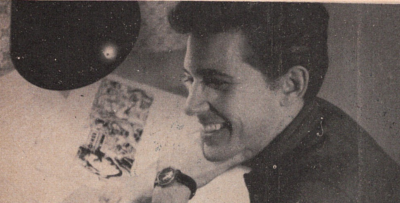
Robert Post:
There was some things with commercial art that Jim had some problems. Jim’s cartooning was his predominant factor in the art field. Above all things he is a first class cartoonist, before he would be considered a commercial artist. I know in particular, one specific customer that we have here that Jim used to do flyers for and not any of the flyers that we had ever turned out that Jim worked on did I make any money on, because Jim was so wrapped up in doing a beautiful cartoon job on the flyers that the time that he put in, we could not bill the customer, for the time that he had had put in it.
Robert Post:
I never fought with Jim, never argued with him. I knew what he was trying to accomplish and even though it may not have been profitable at the time, I never harassed him on doing it some other way. In Jim’s cartooning I don’t know if anyone has ever brought this to your attention before you may be aware of it yourself, but very much the cartooning reflected Jim’s life.
Robert Post:
I don’t know who drew Terry and the Pirates but predominantly-
Mozzer:
Milton Caniff.
Robert Post:
Most of Jim’s cartooning follows along the same lines as Terry and the Pirates, and Jim himself in his own personal life was very much related to Terry. And my personal observation is that every girl that I’ve ever seen Jim with always reminded me of the Dragon Lady. This may be just a personal observation, but it was something that I had remarked to Jim about and we had quite a few laughs about it, but his life followed Terry and the Pirates and I’m sure it was as exciting.
Robert Post:
I noticed reading over some of your notes that you listed him as a musician. I would suggest that if the word musician is used in the article as to James Steranko, with all his talents I would say music is probably the one should be put in quotes.
Mozzer:
You know how long he was a “musician”?
Robert Post:
I don’t think it lasted too long. I know there was a group album called the Saints, Inc. which he was head of and I had hired him, not I personally, but the organization at Bowers Country Club that I belonged to at the time had hired him to play Charleston Night. And the music that they played with dancing was fine until it came time to play Charleston. And as the five men on stage, there wasn’t any of them capable of playing the Charleston. So he had to dig up a record so that a group assembly could dance to the Charleston. And of course this was one of the things being that Jim worked for me every day for many days I never left him, live it down that he could not play at Charleston. They played their rock and roll and that’s about all they played. Jim and I over the years have remained very friendly.
Robert Post:
Jim left me for no bad reason. The only reason that Jim left was because there is no commercial art job in a world that would keep Jim Steranko happy forever because he’s creativity excels so much that in commercial art today it becomes so mechanical and he would soon become bored with what he was doing.
Robert Post:
This is why I referred back to these flowers that I told you as a businessman, I should not admit that I would allow an employee to do a job that would lose money for me. But I realized the problems that Jim was having at that time and would continue to have as a commercial artist that he had to express himself. And I felt this was an outlet for a Jim, even though in that particular phase, I was not making money on that particular job, but I did make money on some of the creativity that Jim created for me and my clients. When Jim left, it was hard to replace Jim because there is just no other person in the world that could fill Jim Steranko’s shoes with his talent, wit his ability…
Robert Post:
Jim was really dedicated, hardworking person, whatever he put his mind to he gave it his all. After he left me as you know, he went with Milford Associates and I’m sure that this was probably the main reason that Jim left Milford Associates is because the challenge was not great enough for him to show what he could possibly do.
Robert Post:
He formed SuperGraphics, Inc. And since-
Mozzer:
It’s not really incorporated, is it?
Robert Post:
I think he has incorporated it, I think so but I’m not sure, but I think he has incorporated.
Mozzer:
It’s possible. It’s just that it never says incorporated.
Robert Post:
And in the times that he has been involved with his corporation, I have done quite a few things for him in the printing line and I know many of them have been very profitable.
Robert Post:
I can’t stress hard enough how talented I think this particular individual is. He is the original hippie if there ever was one. Nothing in his life has ever been a follower. He has been a leader and anything he has ever done has always been original. His clothing, his hairstyle, his attitude towards life, his attitude towards the job, his ability to do a job and he is just one of the most fantastic people that I have ever met in my lifetime.
Robert Post:
The only thing that I am to this day disappointed in is the fact that his love and his knowledge of Houdini… I am very disappointed that nothing so far in his lifetime has come of this love and knowledge of Houdini. I know at one time he was approached to do some research work for a television series on Houdini. Whatever happened to it?
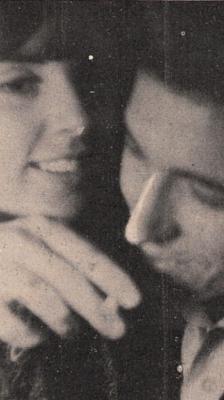
Robert Post:
I don’t know. I know I’ve questioned him many times about it, “When are we going to Hollywood to do Houdini?”, and he just laughs about it. But I feel very disappointed that he has not done something with it because I don’t think there is another living human being today that knows any more about Houdini, about Houdini’s tricks. And if anyone’s going to meet Houdini someplace it’s going to be Jim because this was one of his idols. As you know, Jim was a magician, he was an escape artist and he had duplicated quite a few of Houdini’s tricks.
Robert Post:
And I just feel disappointed that all this talent has gone into the history of comics and the study of the comic book. Not that it isn’t important to Jim, but that the field of escapism and the story of Houdini, there is so much that was unanswered and with his burning desire to find out information.
Robert Post:
I feel very disappointed that he never pursued the story of Houdini or the work of Houdini any further than he did. I don’t know whether Jim is ever going to become a national figure. I know it would never matter to me where he goes or what he does. I will be proud that I have known him and… Maybe just a little proud that I may have had something to do with his success on the way up, because they claim that people like Jim, even though they have talent, they do pick a little bit up from each person as they go through life. And as being his employer at one time I feel as though maybe I have contributed just a little bit and I wish him all the luck in the world and I know he was still friends today and we will be friends forever.
Mozzer:
What position did you hold when he worked for you? Were you-
Robert Post:
I was the owner of the shop then when he worked here.
Mozzer:
Is that president or-
Robert Post:
Yes.
Mozzer:
Then what position does Arthur Rieck hold?
Robert Post:
Arthur Rieck was the previous owner of this business before I bought it from him.
Mozzer:
I know when you are on vacation he was down here last week…
Robert Post:
Mm-hmm (affirmative).
Mozzer:
What type of things do you print Jim? Small or…
Robert Post:
The last thing we did for him was a FOOM. I have no idea what FOOM is.
Mozzer:
Friends of Ol’ Marvel.

Robert Post:
It was a package that they were selling to the kids around the country. I can’t tell you exactly the price of it, but I know they got a book and some labels and a membership card, and it was an international thing that there was some going out in New York and some of them going out of London, England. He was involved in an international thing as far as this was to do with comic papers and comic books.
Robert Post:
And I know we printed thousands and thousands and thousands of these things for him. If they sold them all, I’m sure that they made a bundle of money.
Mozzer:
Yeah. I’m familiar with those because I stuffed envelopes.
Robert Post:
Oh, you did stuff. I think the first history of comics we printed for Jim or set the type form, I don’t remember off hand, but I know we were involved in the first one and because of the volume, we were not equipped to produce him as fast as he needed. And this is why eventually… In fact, I was the one who suggested to Jim that he take it to Columbia and that was Columbia News in Columbia, Pennsylvania, is where the history of comics is printed or was being printed. Whether it’s being printed there now? I don’t know. This is where he went after he left here. If he’s being printed at Columbia, they’re setting the type at Columbia, because this is where it was being set after he left here.
Mozzer:
Okay. Could you find out the date and the years that he worked here.
Robert Post:
This would go back quite a bit, I would say somewhere between 63 and 65, maybe.
Robert Post [after checking with accountant]:
Okay. Jim Steranko worked for Rieck’s printing January, 1959 to May 1st, 1963.
Mozzer:
Okay. Thanks a lot.
On Steranko 1963-1966 : Quentin Minker Of Milford Associates, 1973 (interview conducted with Ron Schira):
Steranko was on Milford Associates’ payroll from June 1963 to December 1966
Mozzer:
Okay, your name is-
Quentin Minker:
My name is Quentin Minker and I operate a small advertising agency in Reading, Pennsylvania, Milford Associates. I have been asked to record a few of my recollections on the subject of Jim Steranko.
Quentin Minker:
My first contact with Jim, I believe, was in about 1958. When a man with whom I was in partnership, Francis Spots, who was himself a commercial artist… When we needed another artist, at least part-time, he suggested Jim and brought him in.
Quentin Minker:
Jim, as he does even now, looked about six or eight years younger then, than he actually was. Although I believe he was only 18 or 19 at the time. He came into the office in full motorcycle regalia; black leggings, black leather coat, you name it. But he was very pleasant. He did not seem too interested, at the time, in coming with us.
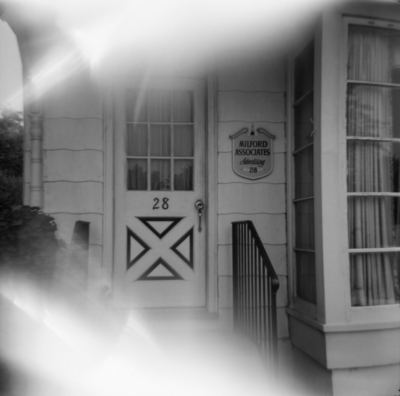
Quentin Minker:
I believe he went to work at Rieck’s Printing. This is another Reading printing house and he must’ve been there for two or three years. After the partnership which I mentioned was dissolved, one day Jim Steranko showed up in my office and he said he had just walked out of Rieck’s, which is not unusual for Jim. He said he liked the way I operated. He didn’t seem to be concerned about too much pressure, and things like that. He said he would really like to come to work for me. Of course, I didn’t have, having lost a couple of accounts, more than a couple of hours a day work for a commercial artist. However, he did come in. And of course he always had many interests on the side and between the working a couple of hours for me and doing other things, which he, as I say had on the fire, why, he kept himself busy.
Quentin Minker:
He was with me, and I should say us because I went through another partnership in 1963, for about two years. Jim worked full-time here. It was, as I say, another partnership and we had more work at that time and Jim was kept pretty busy. But I still think he was working on things like comics and things like that on the side. Of course, I got to know then quite a bit about his background in magic and being an escape artist. Also, I believe, at that time he was operating in a rock band and playing a guitar and I believe he organized it.
Mozzer:
You know the name of the rock band?
Quentin Minker:
No, I don’t recall. I imagine it was something about Jim Steranko but I don’t remember.
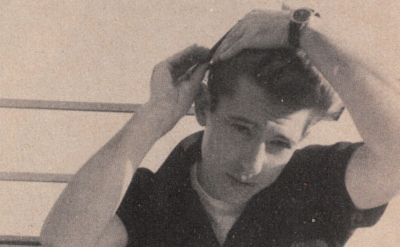
Quentin Minker:
Anyway, he stayed with me then after another partnership dissolving. This is nothing unusual in this kind of business. And again I didn’t have enough to keep him busy full-time but he did use the studio here and the art equipment. I believe that at that time, when he had plenty of time leftover after what he had to do for me, he got into comics seriously. I watched him develop these things from inking in and finishing up jobs for other people on a small scale until finally I think he got some recognition in New York and they gave him a comic to develop on his own. I don’t know what you call it, is that Marvel? It was Marvel Comics, but I don’t remember… is it operating? [ASKING ME WHETHER TAPE RECORDER IS FUNCTIONING.] I don’t remember what the name of his character was.
Mozzer:
Sorry… It’s alright. [CONFIRMING TAPE RECORDER IS FUNCTIONING.]
Quentin Minker:
So he stayed with me, as I say, on a part-time basis for a couple of years. As I believe his habits still are, as they were at that time, almost entirely nocturnal. His idea of the time to start work was at about 4:30 in the afternoon and he would work into the evening as far as it was necessary and sometimes this took, I imagine, until one, two, three o’clock in the morning, and he always had some congenial company with him so I guess the time passed pretty rapidly for him.
Quentin Minker:
Anyway, it came a time when, I believe, that Jim’s outside interests really took precedence over art and I think he felt he was better fitted to get into this comic thing on a full scale and there was more opportunity and more return for him there than he could possibly get as a commercial artist in this town. Which is very, very true because opportunities for making a good living in commercial art in Reading are pretty scarce. So we gradually then drifted apart and he went his way we have remained friends however.
Quentin Minker:
I, of course, had to get artwork done other places, occasionally going back to Jim when the artists that I had couldn’t help. That’s one of the things about Jim Steranko… he has such a whirl and a well of talent that I never did completely plumb the depths of it. He was more apt to give you better work when he had a challenge presented to him than when he was just doing routine commercial artwork, mechanicals and etcetera.
Quentin Minker:
Of course, I’ve kept in contact with him over the last four or five years. He has presented me with some of his publications; the History of Comics, Volumes One and Two I have. He brought his latest newspaper in here, which I believe is published bi monthly. As I say, my latest contact, this was August ’73. He was over here and we sat down and chewed the fat awhile about two and a half months ago. Well that, fairly briefly, is the history of my contact with Jim.
Mozzer:
It seems somewhere I got the impression that he lived in this building. Is that true?

Quentin Minker:
No, he never did. Unless you’d want to call his nighttime working hours living here. No, when he worked for me and even when he worked nights here, he had an apartment at 5th and Spruce, Northeast Corner, Third Floor. And Oh, incidentally he had there a pet rabbit. Did you ever know about that? When the pet rabbit died, Jim was broken up for days, maybe weeks. I don’t know, but it was really a tragedy. So Jim was quite a guy. And as I say, I have all-
Mozzer:
I knew he had a pet rabbit but I didn’t know he died.
Quentin Minker:
Yeah, he did, he died…
Quentin Minker:
I believe he told me he ate the paint off the woodwork and probably died of lead poisoning. So whether he ever got another one, I don’t know. But he kept this rabbit in a pen on the third floor of an apartment which was air-conditioned, of course.

Quentin Minker:
I think there’s where Jim did some of his finest work up till that time anyway. He used to show it to me and I could hardly believe it, first that he had done it or that it was done in this town. It was really first-class stuff. And of course he was working at that time also, as I remember it now, on book jackets, book covers. Of course these had to be very eye-catching because a lot of books are sold on the appearance of the jacket on them. I don’t know how many of these Jim did, but I saw several of them and they were terrific. I think they were terrific…
Mozzer:
Backing up. Who is Milford and when was Milford Associates established?
Quentin Minker:
Well, there’s no Milford really. This is the name of the street I live on. I just picked it out of the air. I couldn’t use my own name in this town because I had the unfortunate experience of having the name that was connected with some racket figures around here, although they are no relation to mine at all. So I went into something else, called it Milford Associates after the street where we made our original agreement on, which is where I live.
Mozzer:
So you did set up this organization?
Quentin Minker:
Oh yeah, I set this up in 1958 and it’s supported me well ever since.
Mozzer:
Do you know anything about Dennis Wayne?
Quentin Minker:
No.
Mozzer:
Did you meet him?
Quentin Minker:
I don’t think… who and what was he? The named Dennis sounds a little bit… Maybe I knew a Dennis, but didn’t know his last name.
Mozzer:
He worked with Jim when Jim worked here.
Quentin Minker:
Well, I can’t say that I recall him. I don’t think Jim needed any help on what he did for me here. He might’ve been inking in and doing things for Jim on the side on his comic work. I don’t know-
Mozzer:
Seems like the last time I talked to you, you knew who I was referring to-
Quentin Minker:
Well, perhaps I did. As I say the name, Dennis, I can’t recall.
Mozzer:
How long ago was it that Jim worked here?
Quentin Minker:
Oh, I think Jim must have severed connections here about, this is ’73, must have been 1969 I believe, in around there somewhere… ’69 to ’70.
Mozzer:
The type of work he did here was probably the most different. Unrecognizable as being his work…
Quentin Minker:
That’s right. It was nothing that would carry any distinctive mark, except perhaps I could tell some of it when he had to do illustrating and whatnot. It was pretty much routine newspaper mechanical work, which of course, nobody can put a trademark on. It’s got to be clean and neat. You’re dealing purely in black and white line. There’s very little opportunity there for expression.
Mozzer:
You know if he worked any place besides here and Rieck’s Printing before going into the comic book business? I know he was-
Quentin Minker:
I don’t think he was on anybody’s payroll in that time. I think from there on he freelanced it and-
Mozzer:
I heard he was a sign-painter, a graphic designer. I guess those things would probably be covered in this-
Quentin Minker:
I don’t know… this man, Francis Spots, my original partner who brought him in here. Then he had been working what really amounted to an art apprenticeship with Spots who was a finished commercial artist at the time. Although I think it didn’t take long for Jim to outrun his instructor. In that case, he probably had more latent and natural talent from the start than his instructor had. It was just a matter of being able to channel it into something, which he did. And at that point, I think, as I say, he left Spots behind because Jim was considerably younger than the instructor and I think he always thought well in advance of anything that Spots would have been doing. I imagine you have to be pretty far-out to put a comic strip together, you got to think pretty far-out.
Quentin Minker:
He had his whole demeanor and even his dress. I think he was one of the originals. I don’t use this term derogatorily. He was one of the original hippies. He dressed in a way that, while it might be common today, it wasn’t common in 1964 or five. You know what I mean? You would probably know that yourself. Of course, he was rarely dressed up in here. Once in a while, he did show up with his yellow jackets and boots and everything. I hardly knew him.
Mozzer:
Anything else you have in mind to say that might be interesting?
Quentin Minker:
No, I think that’s about it. Some of these things, over the years… it’s nearly four years now that he actually worked in close contact with me. As I say, occasionally we’d get together and kick things around a bit. I think that pretty much covers it. No use in me elaborating and concocting and inventing things because I don’t like to do that.
Quentin Minker:
One thing that I didn’t get into is my estimate of Jim as a writer. He, of course had very little opportunity to do anything along those lines here. But I saw his stuff when he was writing the comic histories etcetera, and I know that the things that Jim has written and he’s got more experience writing than I have, are top-flight and have a reason to appear in the very best publications. I think he can match his writing ability against many highly talented copywriters in the big agencies in New York.
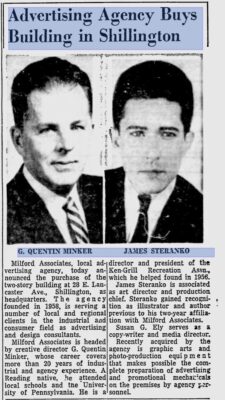
Mozzer:
I heard more than one version of what work he took in to New York when he tried to get into the comic book business. One place I heard that he took a 20-page pencil strip of Super Agent X. Ken Fisher said that he took some complete ink drawings of barbarians and Huns.
Quentin Minker:
I know that I saw his portfolio and I was almost awed by what I saw. It was done in pretty big size. I don’t know how many there were anymore, this is quite a while ago too and-
Schira:
What kind of work did he have in his portfolio? Was it all ink?
Quentin Minker:
Well, yeah. I believe he was pitching for a comic, I guess he was going to Marvel. I’m not sure, but he was pitching for a full-time job. [inaudible 00:14:56], working on other people’s creations and finishing or whatnot or selling what his own imagination had produced. I know that he did take that over there. And I also went over there. It was not easy for Jim to break in because these places are pretty tightly knit and they more or less resent new guys coming in. But I think his sure talent just resolved the thing for him, and that’s about what it amounted to. I think somebody said, “Well, I don’t care where he comes from, what The Boondocks he comes from, this kid’s good and let’s give him a chance”. And I think that’s what happened.
On Steranko 1960s: Eve Machemer Of The Book Store, 1973: (interview conducted with Thomas Miller)
Eve Machemer:
Tom and these boys told me that that’s Steranko. I think Tom or one of the boys had a picture of him and I almost fell in back of the counter. I said, “Is that really him?” Until he told me about this Green Hornet, or Green Lantern, whatever it was, then I really believed him.
Mozzer:
Let’s back up then. You did meet him before you knew who he was?
Eve Machemer:
Oh absolutely, sure. I remember…
Mozzer:
Yeah.
Eve Machemer:
What did his name mean to everybody then, you know? But he used to say to me, “I’m not a dealer. I’m an artist.” I believe he… The time that he got his first contract in New York. The big one, they signed the contract. And he said to me, “Well…” That was when he told me about save all your issues of the Green Lantern, right?
Mozzer:
Green Hornet
Eve Machemer:
The Green Hornet, the Green Hornet, yes. Then he said, “Well I went to New York and I had an interview. Took a bunch of drawings over.” And he said, “I think I’m going to get it.” And he did. And that’s the last I saw him until I read that article in the paper saying that he did get this big contract with this big publishing house in New York and published… And the Green Hornet was one of them and shortly after that it did come back on television as a series. But I just never, never believed him. He was in here all the time.
Eve Machemer:
And when I opened up here, I had all these comic books here on the counter. And then kids would start to say to me, “Don’t sell those. Those are old books, those are old books. Put those back. You can get more than two cents.” I used to sell them for two cents. Give them a penny, then sell them again. And he’d come in and buys stacks of them. And all he was really buying them for was to copy the artwork from… I didn’t realize it then. I know it now. And he used to tell me that. The minute he’d walk out, I’d say smart stuff to myself like, “Oh, big whoop. Who does he think he’s…”
Eve Machemer:
I got so far ahead of him. And as soon as I’d see him, I’d grab books and shove them. And he’d say to me, “Eve, why don’t you sell me those books? I’ll pay you for them.” And I said, “You are a dealer.” “I am not. What must I do to convince you?” He said, “I can go right down to 6th Street and get all I want.” And I’d say, “Well…” And then he got a little pretty girl with him, and she’d look at me like, “Oh, someday you’ll find out.” And that’s how… that was my experience with him. Until the last time I saw him was when he told he thinks he stood a good chance of getting that job in New York.
Eve Machemer:
And later then, Tom wrote, remember the kids started to get older, and I think Tom and Jerry…
Mozzer:
Tom who?
Eve Machemer:
Do you remember Ansel? Remember the blond-haired boy that used to come in here? And Tom… There were about eight boys, they still collect. I’d say they’re about 19, 20 now, and then Jerry, you know Jerry.
Mozzer:
Yeah, Jerry Simon
Eve Machemer:
Jerry’s the one then that showed all the… Well I had seen it in the paper. He had a big write-up you had in the Sunday Eagle. And I said, “Oh my God. That’s the guy I used to treat like a worm when he came in here.” And he was so nice. I think he sort of got a kick out of it too. He’s nice.
Miller:
He was just a little boy when he came in here or…
Eve Machemer:
No, no. He was grown up. He was a man. Well how old is he now would you say? About 29?
Mozzer:
30. 34 I would say.
Eve Machemer:
34, yeah. Good looking. I thought he was nice looking.

Mozzer:
Where did live then?
Eve Machemer:
I have no idea. Well, I don’t know. I figure he was from somewhere on the southside. I have no… I never asked him. And then I was open until 11 o’clock at night. And he must’ve been working somewhere because he came in a lot of nights, you know, nighttimes. And he’d stay for maybe an hour.
Mozzer:
Oh yeah, he works at night. He gets up about 5:00 and goes to bed at 7:30 AM.
Eve Machemer:
Yeah, this was… He has a place in Reading now, doesn’t he? Obviously a studio.
Mozzer:
On 6th Street.
Eve Machemer:
Yeah. Isn’t that funny. When I think back in that day. I would never had known it was the same guy until Jerry showed me the picture. He showed me his name on some of the artwork, on some of the covers of the magazine. You met him, didn’t you?
Miller:
Yes, yes.
Mozzer:
Was this shop here when you came in?
Eve Machemer:
This shop’s been here about 30 years. 35 years, but Schneider had it for 25. 17 was here before that but not books. See, Mr. Schneider knew about books. I don’t. Just what I picked up from back of the counter. But he I think, he came in here when Mr. Schneider had the place.
Mozzer: Steranko?
Eve Machemer:
Yes. I was to him. He was always so nice to me. And then I cut that article out about him in that Sunday paper and I’ve been through my attic a dozen times. You have the article, Tom.
Miller :
I think you have it. [Directed to Mozzer.]
Eve Machemer:
You have it too, don’t you? I’ve cut that part of the paper out and kept it too.
Miller:
I never even saw it.
Mozzer:
I don’t see how you could miss it.
Miller:
Well, I don’t read the paper.
Mozzer:
I don’t see how you could miss it. Well I probably don’t read the paper.
Eve Machemer:
Oh, he had a fabulous article. Right after he told me he thought he was going to New York to apply, to submit his application and his resume, and I remember he had a [inaudible 00:07:15] about that day.
Miller:
This is not the recent article you’re talking about?
Eve Machemer:
No, No.
Mozzer:
It was about ’67, right?
Eve Machemer:
Right. When he first got that job in New York with the big publishing company.
Mozzer:
Marvel.
Eve Machemer:
Marvel, right. And he said he had this resume. And I remember him saying, “This is my resume I’m going to submit. What do you think about Eve?” And I said, “Well, if it’s all true,” I said, “My God, you should get that.”
Mozzer:
Did he show you any of his work?
Eve Machemer:
No, he never did. No, mm-mm (negative). Because he knew I wouldn’t believe him. And I don’t know why.
Eve Machemer:
Because all these kids had put this in my head, see? And he’d stand back there. He was not looking for old comic books. He was looking for certain artists.
Mozzer:
Reference material.
Eve Machemer:
Right, right, exactly. And then towards the end, I did believe him, and I’d say, “Oh let him to…” “Let me see those back there, Eve.” And I’d say, “Go ahead. I don’t care.” He was looking for certain artists that he admired, for reference, see? And I remember when he had that exact letter. He said, “Now this is all right to mail,” the letter I mailed in. Why he would’ve got that. I think he earns about $50,000 a year, right?
Mozzer:
I don’t know.
Eve Machemer:
Well [inaudible] jobs pay good and you have to have at least $35,000 a year to live in New York. You know, live decently.
Mozzer:
He never lived in New York though.
Eve Machemer:
He had to live there when he was working there. He didn’t commute.
Mozzer:
He sent his work through the mail.
Eve Machemer:
Oh, did he? Did he do that? Is that what he did?
Mozzer:
Yeah.
Eve Machemer:
I thought he was… I pictured him in a big suite of rooms in some fancy hotel.
Mozzer:
No, as far as I know he’s always lived in Reading.
for more on John A. Mozzer:
www.flickr.com/photos/mozzermemories/
Images and Photos above ©Their Respective Copyright holders
Join us for more discussion at our Facebook group
check out our CBH documentary videos on our CBH Youtube Channel
get some historic comic book shirts, pillows, etc at CBH Merchandise
check out our CBH Podcast available on Apple Podcasts, Google PlayerFM and Stitcher.
Use of images are not intended to infringe on copyright, but merely used for academic purpose.








